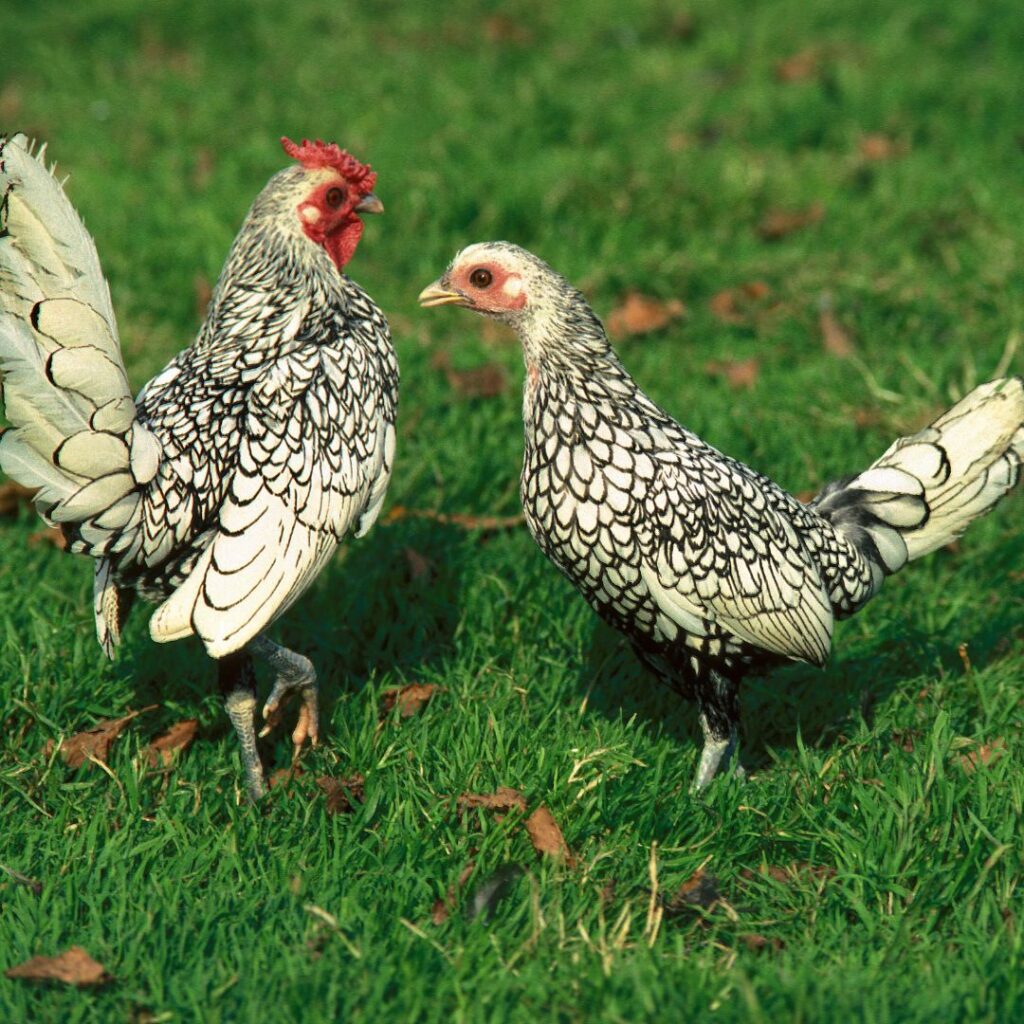If you’re a hobby farmer or backyard chicken owner looking to add something unique and different to your flock, a quirky or rare chicken breed can be a great option. However, it’s always important to research before bringing a new breed home.
The benefits of owning quirky or rare breeds include introducing some excitement and entertainment to your flock. In contrast, pitfalls can be difficulty tracking specific species, and some chickens may require special care based on their unique characteristics.
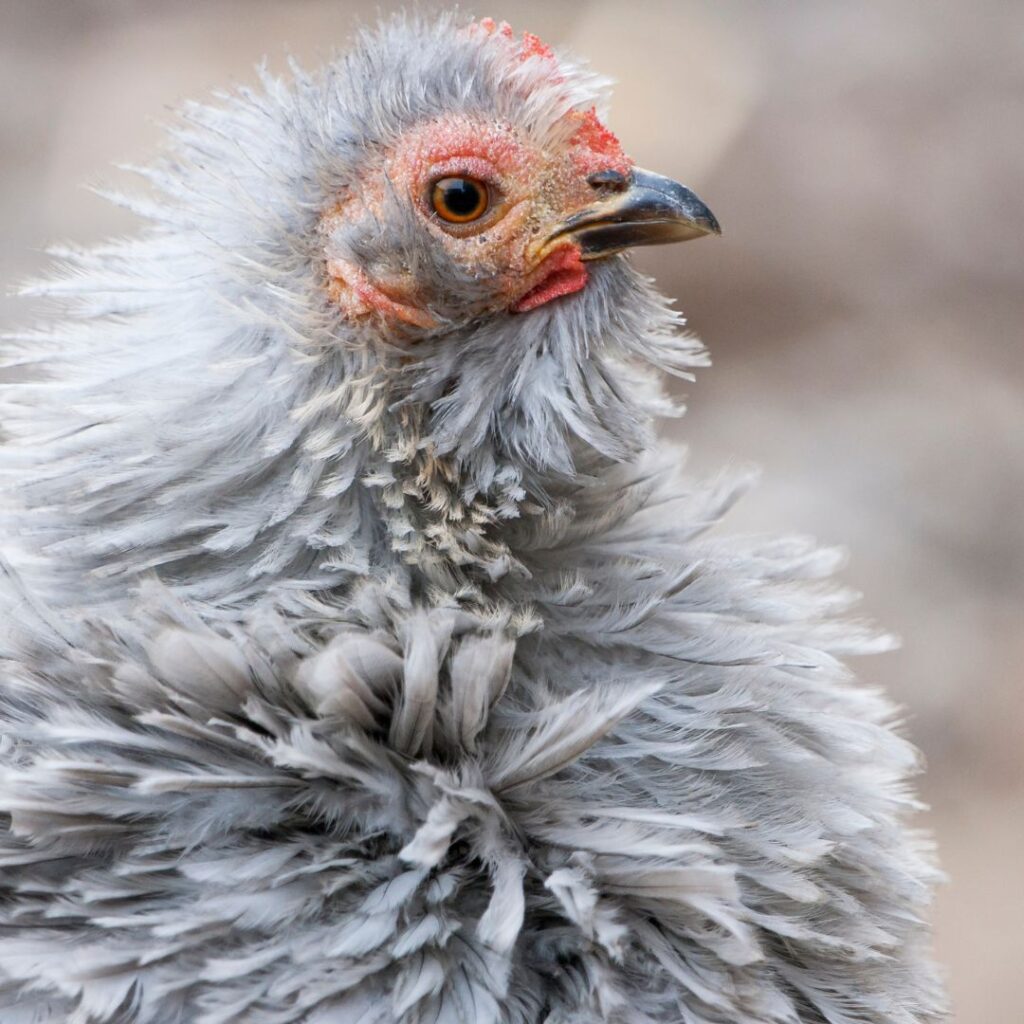
When making this decision, hobby farmers and chicken owners must also consider the breed’s temperament, space needs, and egg-laying abilities.
Choosing a quirky or rare chicken can transform your flock from “ordinary” to “extraordinary.” More importantly, owning rare and peculiar chicken breeds can be an enjoyable and educational experience for families and hobby farmers.
What Makes For Quirky Chicken Breeds?
Quirky chickens are personalities or appearances that are peculiar or out of the ‘normal’ everyday chicken. The appearances, personalities, or both may be unexpectedly delightful or quite alarming if they are more assertive than many know chickens to be.
Araucana chickens
Araucana chickens have quirky appearances with no, lay blue eggs, and have unpredictable personalities; these all make for an exciting chicken to add to your backyard flock.
The Araucana originates from South America, making this breed ideal for warmer climates. However, their pea combs contribute to helping them to protect themselves from frostbite in cold temperatures.
The physical characteristics of Araucanas are distinct and can be recognized easily. They have a small pea comb on their head.
The Araucana chickens have ear tufts with a cluster of feathers near their ears.
The most noticeable feature of Araucanas chicken breeds is their absence of a tail. They are rumpless, which means they do not have tail feathers.
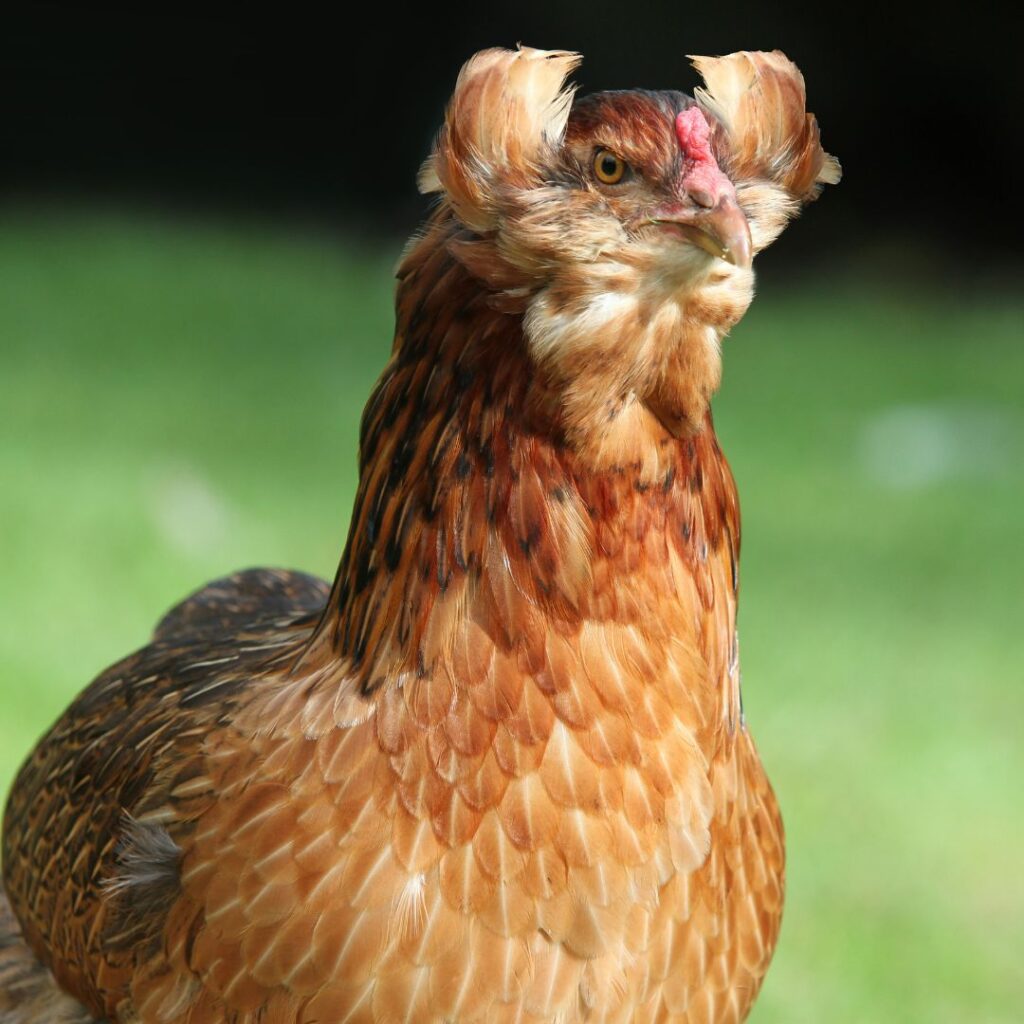
- Recognized by APA: Yes, in 1976
- TLC List: Yes, on the “Study List”
- Cold Hardy: Yes, with precautions
- Heat Tolerant: Yes
- Meat: No
- Size: Hens –4 lbs, Roosters – 5 lbs
- Eggs: 180 – 260 medium blue eggs per year
- Broody: Yes
- Rooster to Hen Ratio: 1 rooster: 4 hens
- Personality: – Flighty, personalities vary from very friendly to skittish
Ayam Cemani
Ayam Cemani chickens are one of the most exotic breeds in the world. They are entirely black. Their entire body, including their feathers, skin, bones, and organs, are black, making them an intriguing sight to see.
Despite their dark appearance, they are gentle and make great pets. They could be better layers, but they’re highly sought after in some areas of the world for their table qualities.
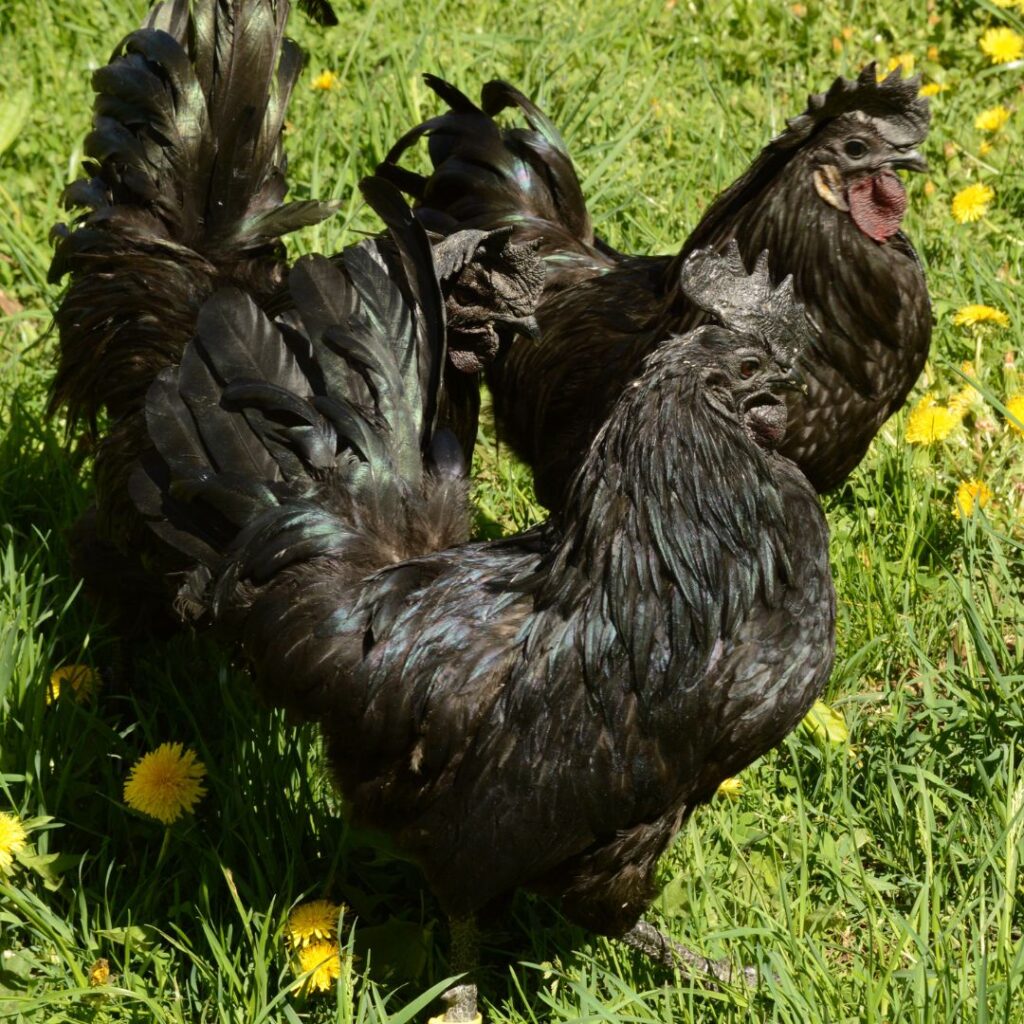
- Recognized by APA: No
- TLC List: No
- Cold Hardy: Yes, with proper shelter
- Heat Tolerant: Yes, with adequate shade areas
- Dual Purpose: Yes (Black)
- Size: Hen –4 1/2 lbs, Rooster – 7 lbs
- Eggs: 80-120 Medium cream-colored (also light tan) eggs per year. Occasionally you’ll have a hen that appears to lay pink eggs; from the coloration, the bloom gives to the light tan.
- Broody: Rarely
- Rooster to Hen Ratio: 1 rooster: 10 hens
- Personality: – Gentle, calm and friendly, docile. Roosters can be quite protective over their flock, even at a young age.
Cream Legbar
The Cream Legbars are a rare and unusual British chicken breed. This breed is also known as being one of the first autosexing breeds.
Autosexing allows the gender of chicks to be identified by down pattern and color upon hatching.
The Cream Legbar was developed by cross-breeding the Gold Legbar with the White Leghorn as well as the cream-colored Araucana chicken. The Araucanas introduced the dilute creme gene, the crest, and the blue eggs into the breed. Read more about the Cream Legbar here.
This breed is also easily identified by the feather crests atop their heads.
Note: the original Legbar was developed using the Leghorn (Leg) and the Barred Rock (bar) – both known for healthy egg products)
The Cream Legbar was standardized in 1958 but nearly died out in the 1970s.
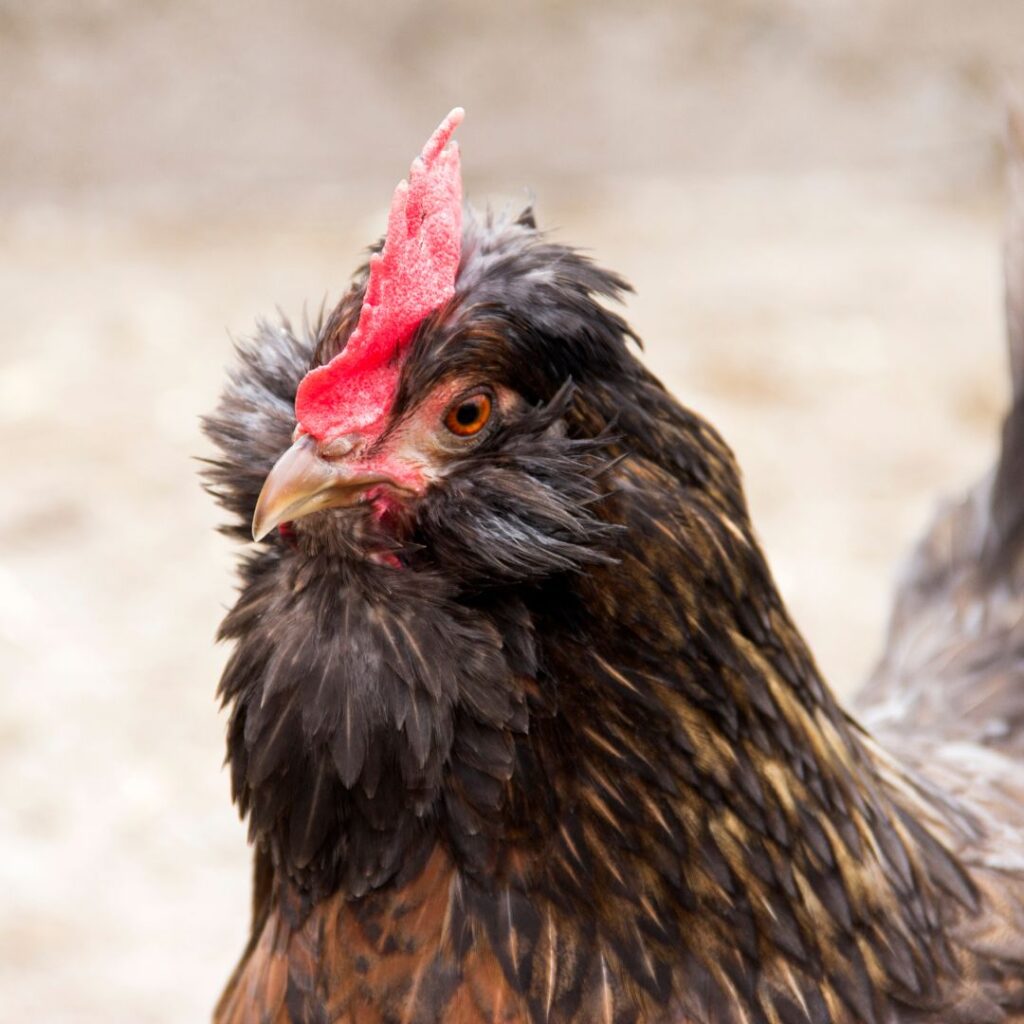
- Recognized by APA: No
- TLC List: No
- Cold Hardy: Yes
- Heat Tolerant: Yes
- Meat: No
- Size: Hen – 5 lbs, Rooster – 7.5 lbs
- Egg: 180 – 200 medium – large blue to green eggs per year
- Broody: Rarely
- Rooster to Hen Ratio: 1 rooster: 10 hens
- Personality: – Friendly, get along well with other breeds of similar size and personality. Roosters can be assertive and even aggressive when protecting their girls.
Dong Tao Chicken
The Dragon Chicken: Dong Tao chicken is a rare chicken from Vietnam. This unique breed has incredibly thick large scaly feet and legs, nicknamed “Dragon Chicken”, which can appear to be one of wierd chicken breeds on this list.
These rare chickens have a striking look about them with their multiple colors of feathers. Despite the size of their feet and legs, Dong Tao chickens are considered a light breed and can fly relatively well.
- Recognized by APA: No
- TLC List: No, however, known as an extremely rare breed as it was not exported to the U.S. and other countries.
- Cold Hardy: Yes, once fully matured around 8-12 mos; great care must be used for frostbite on feet, combs, and wattles.
- Heat Tolerant: Yes
- Dual Purpose: Yes, these birds were once bred for royalty.
- Size: Hens – xx lbs, Roosters – xxx lbs
- Eggs: 60 – 70 medium white tinted or very light brown eggs per year (not much!)
- Broody: Rarely
- Rooster to Hen Ratio: 1 rooster: 8 hens
- Personality: – They make great backyard pets as they’re both social and curious.
Naked Neck Chickens; Turkens
The Naked Neck chicken, often called Turkens, Churkeys, and Transylvanian Naked Necks are, quirky-looking chicken with no relation to turkeys whatsoever.
The Naked necks have no neck feathers and 40-59% less feathers than other breeds.
Naked-neck chickens are known to be quite chatty and with comical personalities.
This surprisingly hardy breed does well in warm and cold climates and makes an excellent dual purpose breed.

- Recognized by APA: Yes, in 1965
- TLC List:ries. No
- Cold Hardy: With proper precautions, dry coop, and run area
- Heat Tolerant: Yes
- Dual Purpose: Excellent
- Size: Hens – 6 1/2 lbs, Roosters – 8 1/2 lbs
- Egg Production: 200 – 240 large brown eggs yearly
- Broody: Occasionally – Likely
- Rooster to Hen Ratio: 1 rooster: 10 hens
- Personality: Friendly, very chatty, and quirky personalities
Featherless chicken (not technically a breed)
Not to be confused with the Naked Neck Chicken, the featherless chicken is a genetically created chicken with the meat industry in mind; these chickens are designed to need less feed and be featherless for easy processing.
Naked Neck VS Featherless Chicken: The Naked Neck is also a much more productive egg layer.
Featherless chickens have downsides, including being less tolerant of extreme weather conditions because of a lack of feathering.
They are also more susceptible to lice and ticks, making them at higher risk of disease.
Onagadori Chicken
Onagadori chickens are a Japanese national natural treasure. Onagadori chicken, when translated, means “Long Tail Fowl” and “Honorable Fowl.”
The Onagadori chickens, especially roosters, are known for being beautiful chickens with tails length in excess of 4 feet.
- Recognized by APA: No
- TLC List: No
- Cold Hardy: Not unless housed indoors
- Heat Tolerant: Yes
- Meat: No
- Size: Hen –3 lbs, Rooster – 5 lbs
- Egg: 80-100 per year
- Broody: Rarely
- Rooster to Hen Ratio: 1 Rooster: 8 Hens
- Personality: Docile, calm, and friendly
Polish Chickens
The Polish chicken, known as the “pom pom” or “top hat” breed, sports a distinctive puff of head feathers.
They are an old breed, today seen mostly in poultry shows as an ornamental breed.
A Polish chicken breed that comes in a variety of color combinations.

- Recognized by APA: Yes, in 1883
- TLC List: Yes, on the Watch list
- Cold Hardy: Not so much
- Heat Tolerant: Yes
- Dual Purpose: No
- Size: Hen – 4 1/2 lbs, Roosters – 6 lbs
- Egg: 100- 150 white eggs a year
- Broody: Rarely
- Rooster to Hen Ratio: 1 Rooster: 7 Hens
- Personality: Friendly and docile. However, their head feathers can block sight, making them skittish when approached without warning. This can also make them flighty. Consider trimming feathers around their line of sight; this will help them feel more secure and safe.
- Read more details on the Polish Chickens here.
Scots Dumpy
This chicken is an ancient breed with origins in Scotland. Scots Dumpy chickens have a dwarfing gene, also known as the creeper gene, giving them extremely short legs (approximately 1 1/5 inches). They’re known to have broad bodies.
The Dumpy has also been referred to by names such as Bakie, Corlaigh, Crawler, Creeper, and Stumpy.
- Recognized by APA:
- ALC List: Listed with Rare Breeds Survival Trust (RBST)
- Cold Hardy: Yes
- Heat Tolerant: Yes, with shady areas
- Meat Production: Yes
- Size: Hens – 6 lbs, Roosters – 7 lbs
- Egg: 150-180 large cream-tinted eggs
- Broody: Yes
- Personality: Docile, calm, friendly – laid back; can be prone to becoming overweight
Silkie Chicken
These birds are famous for their fluffy, silk-like feathered feet, legs, and bodies. Silkie chickens come in various colors and have black skin and bones, a unique trait not found in many other chicken breeds.
They are classified as Bantams (miniature chickens). The Silkie chicken is a ‘true’ bantam meaning there is no standard (full-sized) breed of Silkie chicken.
The black skin made them rare and popular for their table presence, even though their bodies did not carry much meat at all.
Today they are primarily kept as ornamental breeds and are often seen at poultry shows.
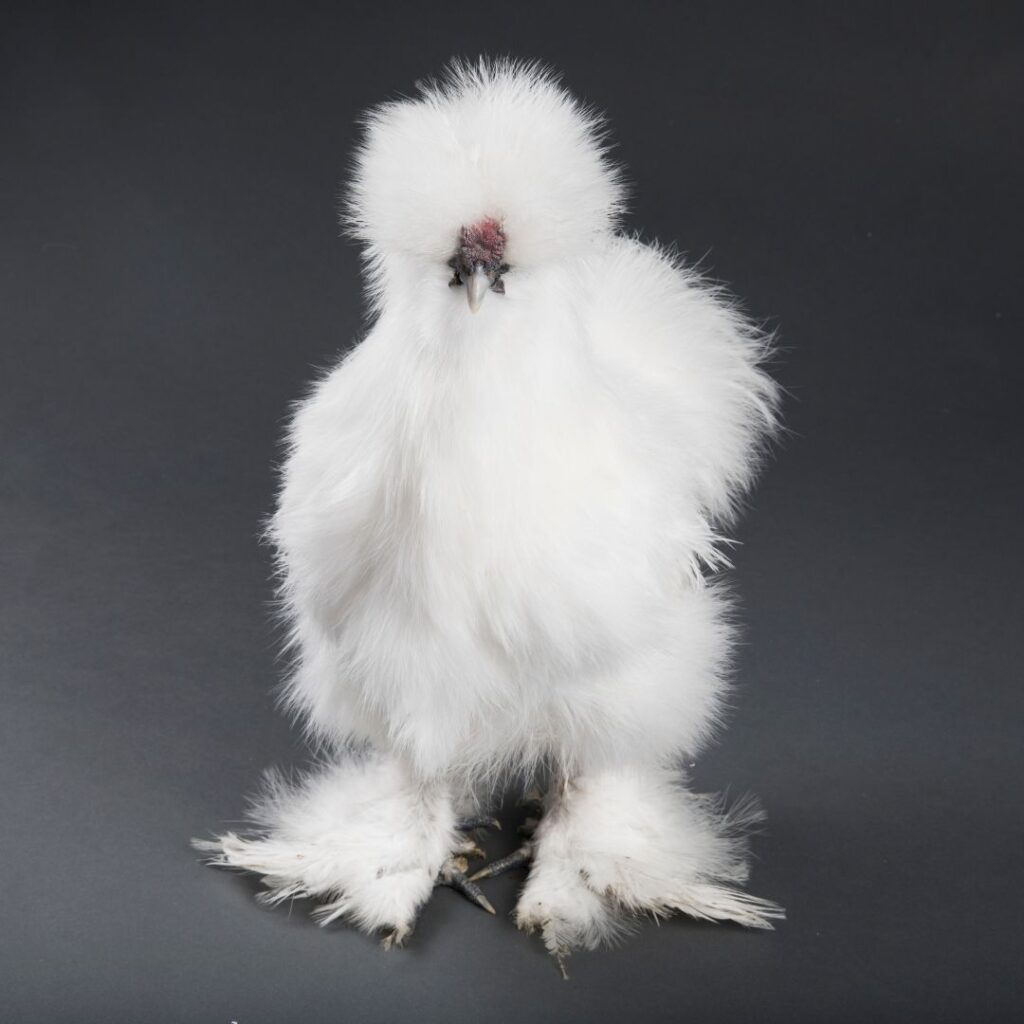
- Recognized by APA: Yes, in 1874
- TLC List: No.
- Cold Hardy: Yes
- Heat Tolerant: Yes
- Meat: No
- Size: Hen – 2 lbs, Rooster – 2 1/2 lbs
- Eggs: (Bantam size) small white eggs that can be cream tinted
- Broody: Extremely
- Rooster to Hen Ratio: 1 Rooster: 6 Hens
- Personality: Calm and Sweet, often described as “lap chickens” because they love to be held and cuddled by their owners.
11 Interesting And Rare Chicken Breeds
Rare chicken breeds in the chicken world are determined by the Livestock Conservancy.
The definition of a rare chicken breed is actually categorized as a chicken breed on the critical list with The Livestock Conservancy (TLC).
- Fewer than 500 chickens are in the U.S.
- Worldwide Population is fewer than 1000 chickens.
La Fleche Chicken
The La Fleche chicken is sometimes called the “Devil bird” because of its unusual v-shaped comb. The word La Fleche means arrow in French, and that may also have contributed to its name with the v-shaped comb pointing like an arrow downwards. With its devilish appearance, this bird isn’t making it to any most beautiful chicken breeds list soon.
These birds prefer foraging and free-range life much more than confinement.
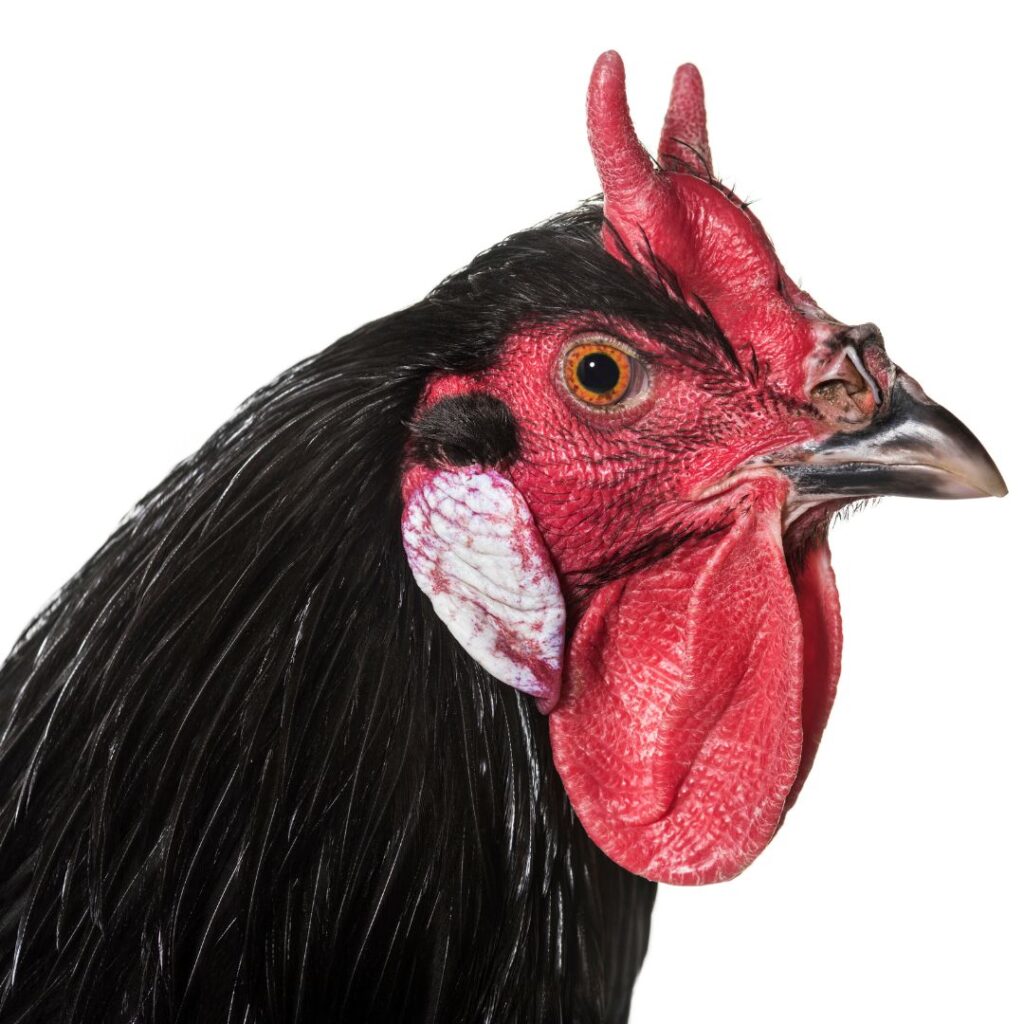
- Recognized by APA: Yes, in 1874
- ALC List: Yes, Critical list
- Cold Hardy: No
- Heat Tolerant: Yes
- Meat: Excellent
- Size: Hens –6 1/2 lbs, Roosters – 8 lbs
- Egg: large – 140 – 220 extra large white or cream colored per year
- Broody: Rarely – never
- Personality: Active, flighty, aloof to humans, not known as pets; however, it will provide you with excellent foraging benefits if able to free range. A great choice for a dual-purpose bird, weed, tick, and grub control.
Modern Game Chickens
The Modern Game chicken breed originated in England from a cross of Malay and Old English Game chickens.
The breed was created as a result of the ban on cockfighting in 1849, and fanciers began showing their birds instead of fighting them.
By 1910, these breeds had been dubbed “Modern Game” and were known for their tall, sleek appearance and hard feathering.
These birds had long legs and looked very similar to the Modern Game chicken breed we see today.
While they are great for exhibition and ornamental purposes (long-tailed chicken), they are not known for being a table birds and laying a few eggs, which has caused their popularity to dwindle over the years.
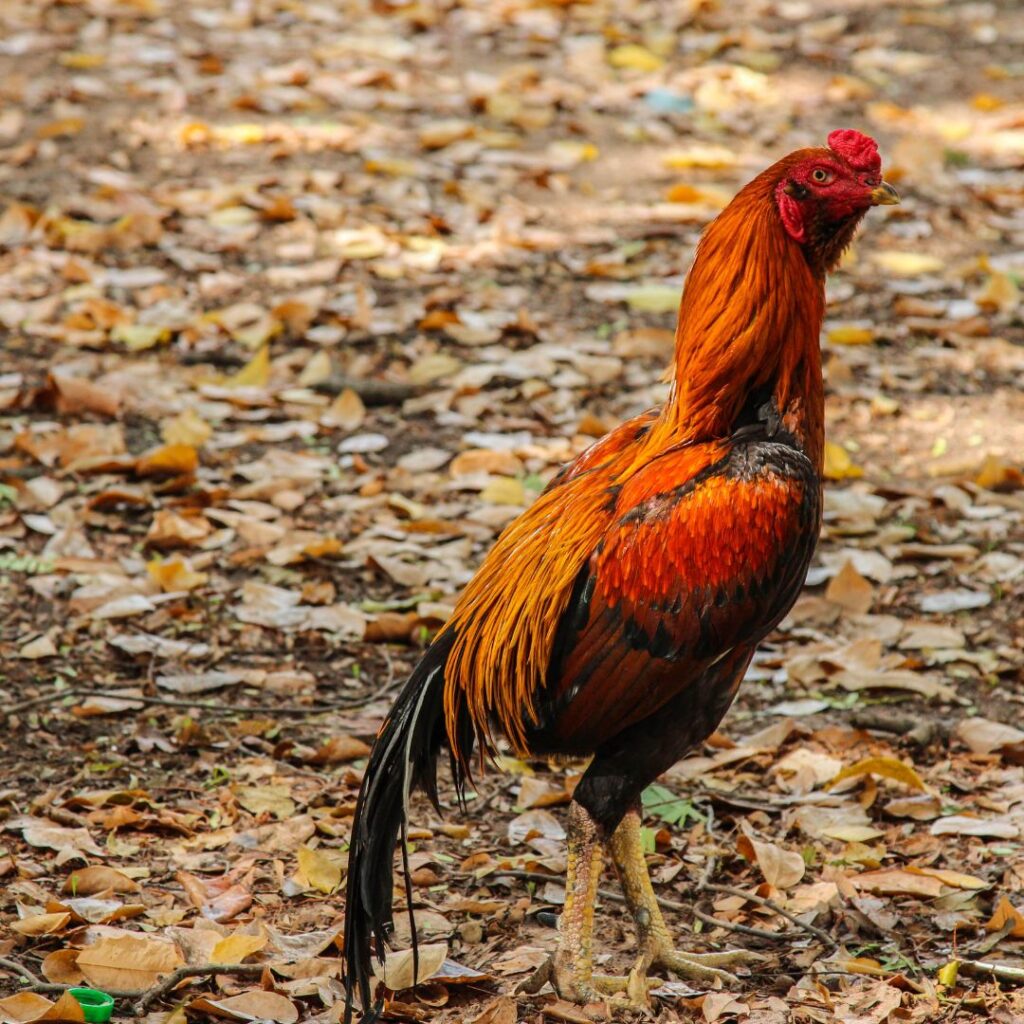
- Recognized by APA: Yes, in 1874
- ALC List: Yes, Critical list
- Cold Hardy: No
- Heat Tolerant: Yes
- Meat: No
- Size: Hen – 4 1/2 lbs, Roosters – 6 lbs
- Egg: 50 – 80 small to medium white eggs per year
- Broody: Rarely
- Rooster to Hen Ratio: 1 Rooster: 6 Hens
- Personality: Curious, active, friendly
Sultan Chicken Breed
The White Sultan a breed that is rare but unique. The Sultan is quite different from any other breed, with more distinguishing features than you can count on one hand.
Everything about this bird is striking, from the V-shaped comb to the feathered shanks and five toes, which are slate colored underneath that feathering. They fashion crests, bears, muffs, and feathering that droop hiding thighs and the top part of the hocks.
Despite once being a popular breed, the Sultans almost went extinct in the 1930s and remain rare today.
One of the most noteworthy features is the vulture hocks, which give the bird an unmistakable appearance.
- Recognized by APA: Yes, in 1874
- TLC List: Yes, Critical status
- Cold Hardy: No
- Heat Tolerant: Yes
- Meat: No
- Size: Hen – 4 lbs, Rooster – 6 lbs
- Egg: small white eggs annually
- Broody: Rarely
- Rooster to Hen Ratio: 1 Rooster: 7 Hens
- Personality: Sweet, docile, friendly
11 chicken Breeds FOUND On The Critical (Rare Breed) List
Campine
Crèvecoeur
Holland (extremely rare)
La Fleche Chicken
Malay
Modern Game
Nankin
Redcap
Spanish
Sultan
Yokohama
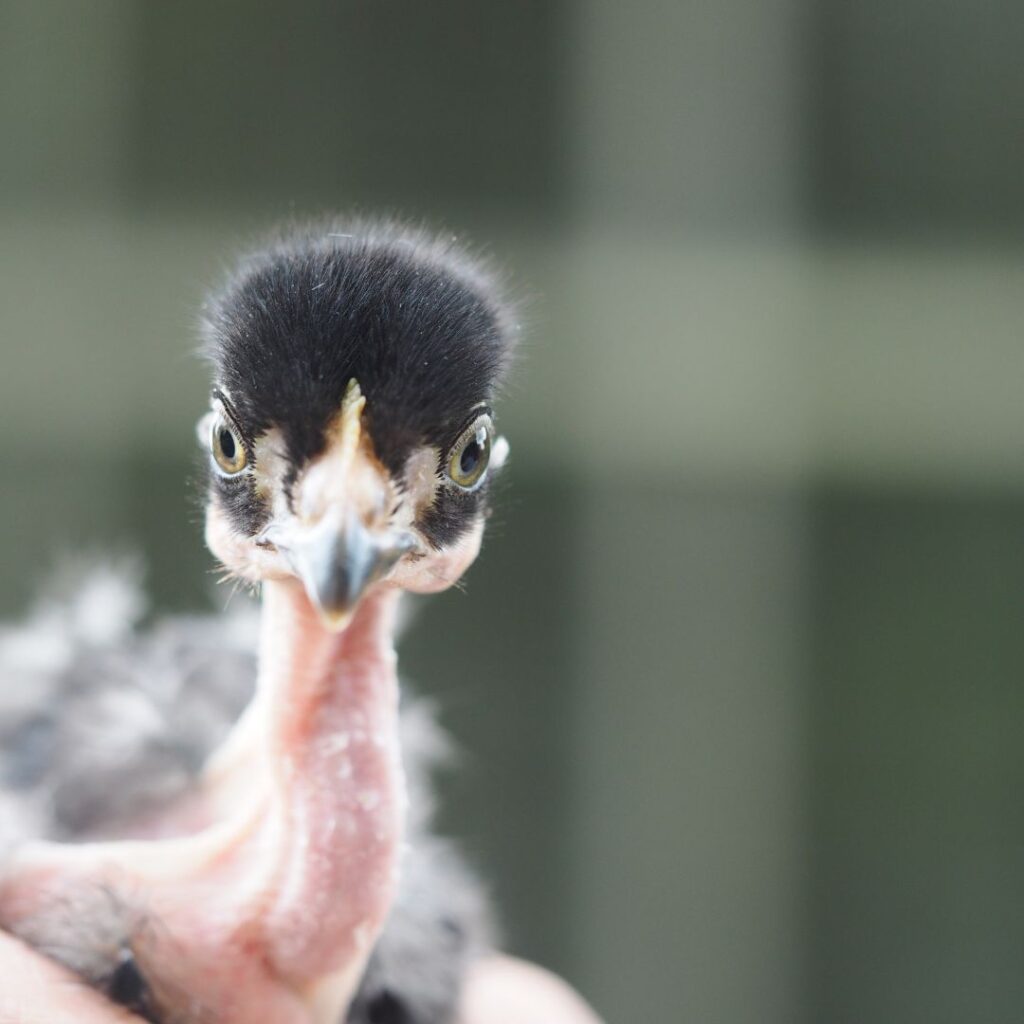
If You’re Raising Chickens, What Odd or Rare Chicken Breeds Are for You?
If you’re a hobby farmer or backyard chicken owner looking to add something unique and different to your flock, a quirky chicken with an unusual appearance can be a great option. However, remember to do your research before bringing a new breed home, not all breeds are easy as a Buff Orpington or Rhode Island Red.
Benefits of owning quirky or rare chicken breeds include introducing some excitement and entertainment to your flock.
When making this decision, hobby farmers and chicken owners must also consider the breed’s temperament, how well a new breed will get along with other birds, and space needs. Chicken owners also need to think about how their flock can handle harsh cold winters and extreme heat areas and the feed needs to raise healthy chickens.
Choosing a quirky or rare chicken breed can transform your flock from “ordinary” to “extraordinary.”
More importantly, owning rare and quirky chicken breeds can be a fun and educational experience for families and hobby farmers.

